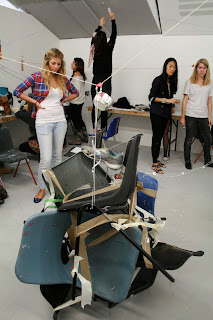After completing both G.C.S.E and A level Fine Art I was truly eager to experiment in other areas of Art and Design and establish what area I would be most suited for. Starting the course with an open mind meant that I was able to take full advantage and make the most of the course and each rotation.
Visual communication was my first rotation and felt this was one of the most successful and enjoyable of the rotations. I was slightly apprehensive because I had never done anything like this before and was really shocked at the pace of work. I soon became used to this way of working and began to thoroughly enjoy it as it allowed me to be more instinctive and experimental with my work. Project 3 (audience) I enjoyed the most as I had the chance to make a short animation - something I had never tried before. I felt that this was quite successful and enjoyed the process of making it. On reflection, Visual communications has helped to change my way of working as I feel I have become more intuitive and expressive.
Both 3-d spatial and fashion textiles were less successful rotations for me. In 3-D spatial I felt that my ideas were being restricted and that the area was too controlled for me. I really did not enjoy the process and way of working in both of these areas, which made me feel slightly lost and out of my depth. Although I liked the drawing aspects in both and felt that I could use these skills in other areas.
Fine art was by far the best rotation for me. I felt there were less limitations in what I could do and that I could be more adventurous and experimental with my work. I feel I am most suited to this area and way of working. I also felt that my work was more successful from this area and was pleased with my final outcome. I have no concrete plans for my creative future but I feel that fine art would push me in the right direction and be the best path for me to take.
So all in all, over these past weeks I have learnt about what style and way of working is best for me, as well as new ways of working. The final outcome is that the decision is between Fine art and Visual communications. I really enjoyed both. However I love the amount of freedom that is involved in fine art and feel I would be able to thrive more in this area, than an area with a more restrictive brief. Over the rotation period my understanding between the differences of Art and Design has become clearer and this is also a reason why fine art is my chosen area to specialise in.













